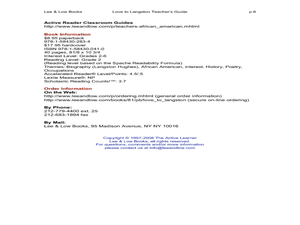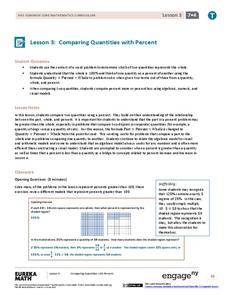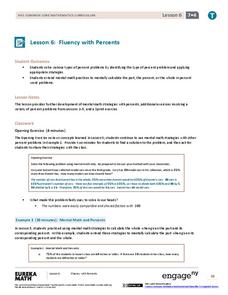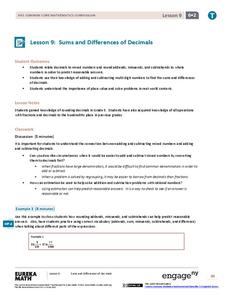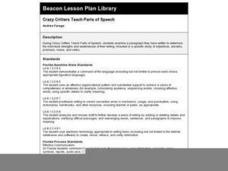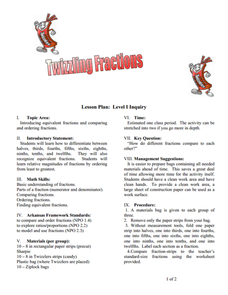Curated OER
Love To Langston
Students complete pre reading, writing, during reading, and interdisciplinary activities for the book Love To Langston. In this reading lesson plan, students complete journal entries, go over vocabulary, answer short answer questions,...
Ohio Department of Education
Fraction Models - Grade Three
Explore fractions using different manipulatives and illustrations. Your class can create a variety of models of fractions and mixed numbers with drawings and manipulatives. They then work to compare fractions, mixed numbers, and whole...
Math12
Basics of Probability
Give your middle schoolers a fighting chance at understanding probability. Offering numerous examples that clearly demonstrate basic probability concepts, this resource helps young mathematicians learn how to visualize the...
Curated OER
Now That's News To Me!
Learners observe how newspapers help to build a sense of community. They identify the important events and people within their school community and create a newspaper page/section. They choose photographs or clippings to use on their...
EngageNY
Comparing Quantities with Percent
Be 100 percent confident who has the most and by how much. Pupils use percentages to help make the comparisons by finding what percent one quantity is of the other. They also determine the percent differences between the two...
West Contra Costa Unified School District
Decimals and Fractions
Reinforce the concept of fractions and decimals as part of a whole with a lesson plan that begins with a mixed review, then goes into a three problem guided practice, and ends with a collaborative activity. The guided practice and...
Virginia Department of Education
Angles, Arcs, and Segments in Circles
Investigate relationships between angles, arcs, and segments in circles. Pupils use geometry software to discover the relationships between angles, arcs, and segments associated with circles. Class members use similar triangles to...
EngageNY
Solving Percent Problems III
What happens when combining percentage discounts? The last lesson in a series of 29 introduces the idea of combining discounts one after another. Pupils wrestle with the claim that to find the total discount, they need to only add...
EngageNY
Fluency with Percents
Pupils build confidence working with percents as they work several types of percent problems to increase their fluency. The resource contains two sets of problems specifically designed to build efficiency in finding solutions of basic...
EngageNY
Population Problems
Find the percent of the population that meets the criteria. The 17th segment of a 20-part unit presents problems that involve percents of a population. Pupils use tape diagrams to create equations to find the percents of subgroups...
EngageNY
Sums and Differences of Decimals
Sometimes dealing with decimals is so much easier than dealing with fractions. The ninth lesson in a 21-part module has the class consider situations when it might be easier to add or subtract fractions by first converting to...
Curated OER
Fractions: Parts of a Set
Students identify, model, and label simple fractions. They describe and define them as equal parts of a whole, a region and a set. Students use words to describe fractions. They use manipulatives to explore the many different fractions.
Curated OER
To Be (Half) Or Not To Be (Half)
First graders demonstrate various ways to represent and verify a whole or set separated in two, three, or four equal parts. Using interlocking cubes, Students model a part of a whole or a part of a set. They use appropriate tools and...
Curated OER
Identifying and Using Parts of Speech in Writing: Technology, Word Processing
Students identify and suggest suitable parts of speech to fill in the blanks in a prepared text (the text can easily be tailored to language ability and desired subject). They use word processing to edit the text.
Curated OER
Introduction to Fractions Using Cuisenaire Rods
Fifth graders use Cuisenaire rods in order to discover how to represent fractions with real objects. In this lesson on fractions, 5th graders first examine and learn the colors, lengths, and numerical values of each rod; then, students...
Curated OER
Digital Parts of Speech
Students investigate different parts of speech by creating digital skits. In this digital education lesson plan, students collaborate in groups to research the Internet for clips and music that represent the different parts of speech....
Curated OER
Crazy Critters Teach Parts of Speech
Middle schoolers create pieces of writing about a creature they have created. They examine the parts of speech and how they are used in their writing to see how they can write more specifically.
Curated OER
Fractions: Jim and John
Elementary and secondary learners investigate various concepts related to the study of fractions. They use word problems during the introduction to parts of a fraction and proceed to some of the basic operations of using fractions. The...
Curated OER
Number Line Mathematics
Students translate problem situations into diagrams, models, and numerals using whole numbers, fractions, mixed numbers, decimals, and percents. They identify that numbers in different forms are equivalent or not equivalent using whole...
University of Arkansas
Twizzling Fractions
Using food as a manipulative is one of the best ways to incorporate hands-on learning in the classroom. This hands-on approach allows young mathematicians to compare, order, and identify fractions with the use of Twizzlers® and...
Curated OER
Stomping and Romping with Shakespeare
Did you know that Green Eggs and Ham is written in iambic pentameter? Model the rhythm of language using Dr. Seuss’s tale. Direct class members to march about the room tapping their right foot on the first syllable and stomping their...
Curated OER
Collective Nouns and Verb Agreement Practice
Break down subject and verb agreement with this exercise. This activity only deals with present tense verbs and collective nouns. Pupils learn how to make the verb of a sentence agree with the collective noun by reading sentences and,...
Curated OER
Interpreting Algebraic Expressions
Interpreting algebraic expressions is a fundamental skill in beginning algebra. This lesson approaches the task in numerous ways. First, learners assess their understanding with a short worksheet on converting between words and...
EngageNY
Problem Solving When the Percent Changes
Use more than one whole to solve percent problems. The ninth installment in a 20-part series has pupils work percent problems in which they must determine two wholes. Individuals use double number lines to represent and solve the...
